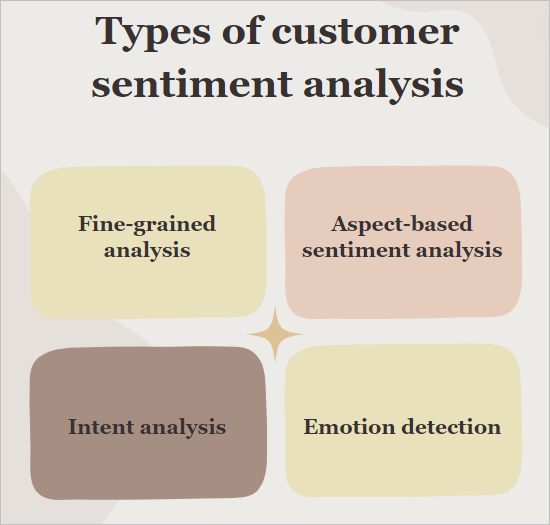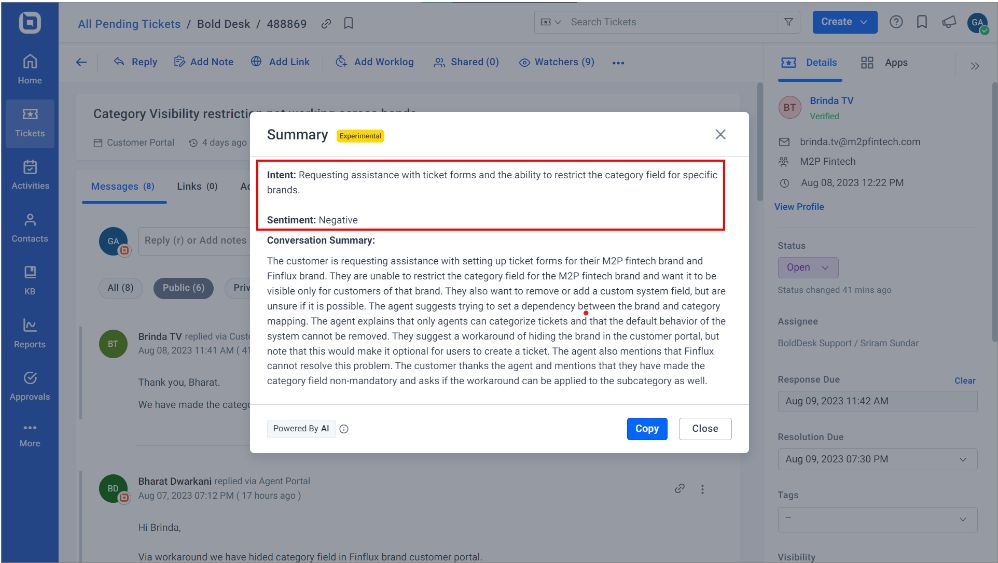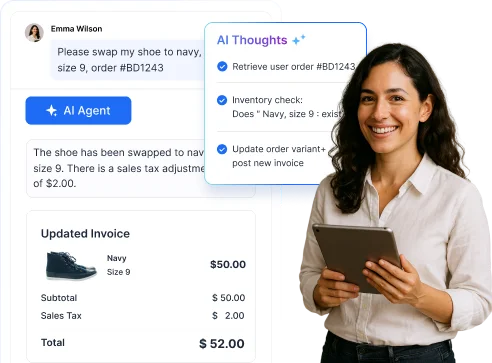What customers think and feel about your business matters. Their opinions can make or break your business. Businesses need to analyze and understand customer sentiment.
This means knowing their overall feelings about the brand or company. This knowledge helps the company make decisions to improve their offerings and satisfy customers.
In this article, we’ll explore customer sentiment, sentiment analysis, and sentiment score.
What is customer sentiment?
Customer sentiment measures customers’ emotions and opinions about a brand or company. Data is gathered from customer interaction with a brand. Sentiment can be neutral, positive, or negative.
These emotions impact customer loyalty and churn. Positive sentiment means customers had a good experience. Negative sentiment means customers had a bad experience, which can lead to customer churn.
Customer sentiment helps you identify your customer pain points. It informs you when you need to make changes to enhance the customer experience.
What is customer sentiment analysis?
Customer sentiment analysis is the process by which companies use business intelligence to examine and understand customers’ emotions and opinions as they relate to the companies’ brand, offerings, and customer service.
This is done through gathering all text produced by customers in relation to those, like reviews, survey responses, customer service conversations, and forum or social media comments.
According to a study published on ScienceDirect, using customer sentiment to improve customer experience is a necessary strategy for success.
Types of customer sentiment analysis
There are many approaches to customer sentiment analysis. Each method measures a particular sentiment. The main models include:

Fine-grained analysis: This checks if the overall text or conversation is positive, neutral, or negative. The sentiment can be graded on custom scales, like 1–5 or 1–10, depending on how fine-grained you need to be.
Aspect-based sentiment analysis: This form of analysis categorizes customer comments into specific subjects, like UI and customer support, and then checks each category of text to understand the emotion behind it.
Intent analysis: This approach looks into customer conversations and determines customers’ intention to purchase or not.
Emotion detection: This approach uses AI to uncover emotions in comments, reviews, and conversation. It then places these emotions into different categories.
What is a customer sentiment score?
A customer sentiment score is a metric companies use to measure the overall feeling of customers. It is often computed by checking each sentiment against a scale. It can be expressed out of a hundred or out of ten. Zero is usually the most negative score, either way.
How to calculate a customer sentiment score
The steps below will guide you on how to come up with a customer sentiment score:
- Collect feedback: Get comments and reviews from customers.
- Pick a method: Choose how you want to analyze sentiment. You can use a set of pre-set sentiment values. You can also use an intelligent computer model.
- Clean up and break down: Make the comments the algorithm has trouble with neater. Break them into single words.
- Get scores: Add up these scores for each comment.
How can you improve customer sentiment?
Now that we know what customer sentiment is, we must understand how to improve it. Positive customer sentiment has a positive effect on your brand.
Encourage feedback through surveys and reviews
First, you must have sources of customer feedback to evaluate. Requesting reviews and sending out satisfaction surveys also makes customers feel valued. You should:
- Make it easy for customers to share their thoughts by offering options at multiple points like post-interaction surveys, post-purchase emails, and social media polls.
- Encourage participation with rewards or discounts.
- If possible, respond to all feedback, both positive and negative, promptly and professionally.
- Acknowledge customer concerns and outline the steps you’re taking to address their feedback.
- Use negative feedback as a valuable learning opportunity to identify areas for improvement.

Engage customer communities through forums
Build a thriving customer community by fostering a dedicated forum or online platform where users can connect, share experiences, and offer peer-to-peer support. This goes beyond simply responding to comments and discussions.
Start conversations online by posing interesting questions or polls. You can cultivate positive brand sentiment by fostering a space for genuine interaction and connection.
Give assurance of your brand’s quality
Customers want proof of quality from sources they trust. Whatever your industry, there’s strategies to use to reassure customers of the quality of your brand. For instance:
- Find third-party review sites your customers will trust, encourage customers to write reviews there, and point potential customers toward those reviews.
- You can repost reviews, ratings, and awards on social media so that your clients can confirm the quality of your brand.
- If applicable, you can also offer free trials for clients to test the quality of your brand.
- Make the brand easy to set up and use for a beginner.
- Make return shipping free for physical products.
Empower employees to exceed customer expectations
When your employees provide excellent support, customers record better satisfaction. You need to train your employees to live up to the best customer service standards.
Provide them with the necessary tools and resources, such as IT help desk software, fast internet, and a good working environment. Support tickets are a simple way to organize and respond to support requests.
The organization a ticketing system provides can significantly improve sentiment through the quick resolution of support issues.
Prioritize areas for improvement
Implement changes and track their impact on sentiment scores:
- Check if the changes you make lead to an increase in negative sentiment. If that is the case, then keep adjusting.
- If the changes lead to an increased overall positive sentiment, then you should maintain these changes.
- Ask customers about specific areas where they want to see changes made.
Constant improvement leads to positive reviews.
Compare your sentiment scores with competitors
Measure your performance in your industry by comparing your sentiment scores with competitors’. Use these comparisons to make the necessary changes to improve customer service practices.
Providing better service than your competitors will improve customer sentiment.
Communicate your plans with your team
Clearly articulate your goals for enhancing sentiment and outline specific action plans for each relevant department. Encourage cross-functional team collaboration and empower your team members to contribute ideas and solutions.
You can create a positive culture and improve sentiment toward your company by fostering transparency and ownership, aligning everyone towards a common goal. It is easier to improve customer experience when everyone is on board.
Benefits of customer sentiment analysis
Analyzing customer sentiment can give you insight that helps your business grow and compete with leaders in your industry.
Identify customer needs and expectations
When you listen to your customer’s feelings and opinions, you can understand what they need and expect from your business.
Negative sentiment shows you that you are not meeting customer expectations. These opinions can also show you whether you should add some features to your offerings.
Boosts the performance of your support team
Customer insights from sentiment analysis form an excellent foundation to train your team to provide service the way that customers prefer.
Gives you tips on how to better your brand or company
Customer sentiment gives you insight into how to improve your brand. It shows what part of your business process needs to be revised. This will ensure you offer what customers need and prefer.
Strengthens marketing efforts through targeted campaigns
Knowing what customers think and want will improve your marketing efforts. These insights help you make a better marketing plan where you can target specific customer segments.
Reduces customer churn
By understanding customers’ feelings about different aspects of your company, you can identify what they like and don’t. In this way, you can adjust and improve your services.
More positive customer sentiment means more customers stay onboard, reducing customer churn.
Measures the success rate of marketing campaigns
You can analyze the ratio of negative and positive sentiment expressed directly on your advertisements, such as comments on social media ads, or indirectly by tracking changes before and after campaigns. This will let you know whether your marketing strategy is successful or not.
How to measure customer sentiment
Companies must understand customer sentiment. But how can you discover and measure it? Here are a few things you need to gauge what your customers feel.
Customer service software
This software uses artificial intelligence to measure sentiment. AI help desk management software can determine the tone of each ticket and gauge whether it is positive, negative, or neutral.
It can recognize, categorize, and highlight customer tickets with the most significant emotional expression.

Most customer service software uses a sentiment score for every feedback response to measure customer sentiments.
Customer feedback surveys
Customer feedback surveys give you direct responses and thus are an excellent source of customer sentiment. They include one-on-one interviews, polls, comment fields, and customer satisfaction surveys (CSATs).
Product reviews
Reviews explain what customers like or do not like about your brand and their lived experience. They offer a quick way to gather customer expression on your products and services for analysis.
Focus groups and community forums
Focus groups and forums are another source of customers writing about your products and services from which you can learn more about their general sentiment toward them.
Monitor social media
Look for comments, mentions, likes, dislikes, and reactions on social media and analyze them to measure customer sentiment. Insights from social media content give you better awareness of your brand image.
Understand customer sentiments to transform your customer experience
By considering your customer’s thoughts, feelings, and opinions, you can understand what they like and don’t like and thus adjust your offerings or business accordingly. Analyzing customer sentiment gives you insights to improve customer service and keep customers happy.
Use BoldDesk’s unique AI and CSAT features to measure customer sentiment in customer support interactions. Gain deeper insight into your customers’ thoughts and feelings and improve your brand’s customer experience. Contact the BoldDesk support team today and schedule a live demo. Explore the features in detail with the BolDesk free trial plan.
I hope this article was a helpful guide in discovering more about customer sentiment analysis. If you seek additional information or have your own ideas to contribute, please share them in the comments section below.
Related articles



















 Email Ticketing System
Email Ticketing System Shared Inbox Software
Shared Inbox Software Multi Brand Help Desk
Multi Brand Help Desk Internal Help Desk Software
Internal Help Desk Software Trouble Ticketing Software
Trouble Ticketing Software Mobile Help Desk
Mobile Help Desk 















